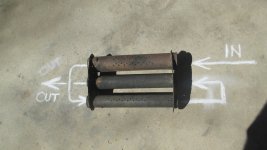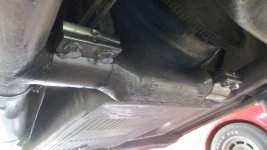Stock "Replacement" Mufflers
When I began restoring my 454" powered '71 six years ago I bought a set of "stock replacement" mufflers from Corvette Central; thinking the big blocks would use less restrictive mufflers. But when I road tested it I found it fell on it's face at only 3500 rpm and immediately suspected the new mufflers caused the enormous drop in power. I cut one of the mufflers open and found it was an ordinary muffler but with a huge 2-1/2" inlet pipe necked down and wended onto the muffler's 2" inlet pipe and a 2" outlet pipe necked down and welded onto the muffler's 1-3/4 outlet pipe. And the internal crossover pipe was only 1-5/8" in diameter. So with 230 cubic inches breathing thru the tiny 1-5/8" crossover pipe it's no wonder it fell on it's face.
Next I tried a set of 40-Series FlowMasters but with my TH700R4 and 3.08 gears the drone inside the cabin was unbearable at cruising speeds. A drone so powerful I could feel it in my chest. Then I decided to make my own mufflers but using big 2-1/2" tubing thruout and they did the trick (sorry I don't have the step-by-step pictures any more). My home made mufflers have the same 17" shell length as the OEM mufflers but with the big 2-1/2" tubing in the inlet, crossover, and outlet and my exhaust tips also having the big 2-1/2" tubing it'll easily rev to 6000 rpm with no trouble whatsoever. They are about 4 times as loud as the OEM but 1/4th as loud as the 40-Series FlowMasters. The 2-1/2" tubing has a .070" wall thickness and the shells are ,060" thick so my mufflers will last a lifetime on 91 octane unleaded.
When I was a kid in the 1950's spark plugs only lasted 10,000 miles and exhaust pipes, mufflers, and tail pipes only lasted 2 years because of the high sulfur content in the gasoline; sulfur that became sulfuric acid when mixed with water. And it was the sulfuric acid and lousy oil bath air filters that destroyed cylinder walls and piston rings in only 90,000 to 100,000 miles and required 3000 mile oil changes to get rid of the acid and dirt. Sulfur and lead was used in the gasoline as lubricants so once the sulfur and lead was eliminated and the vastly superior pleated paper air filters came onto the scene our engines last 3-4 times longer than they did.









